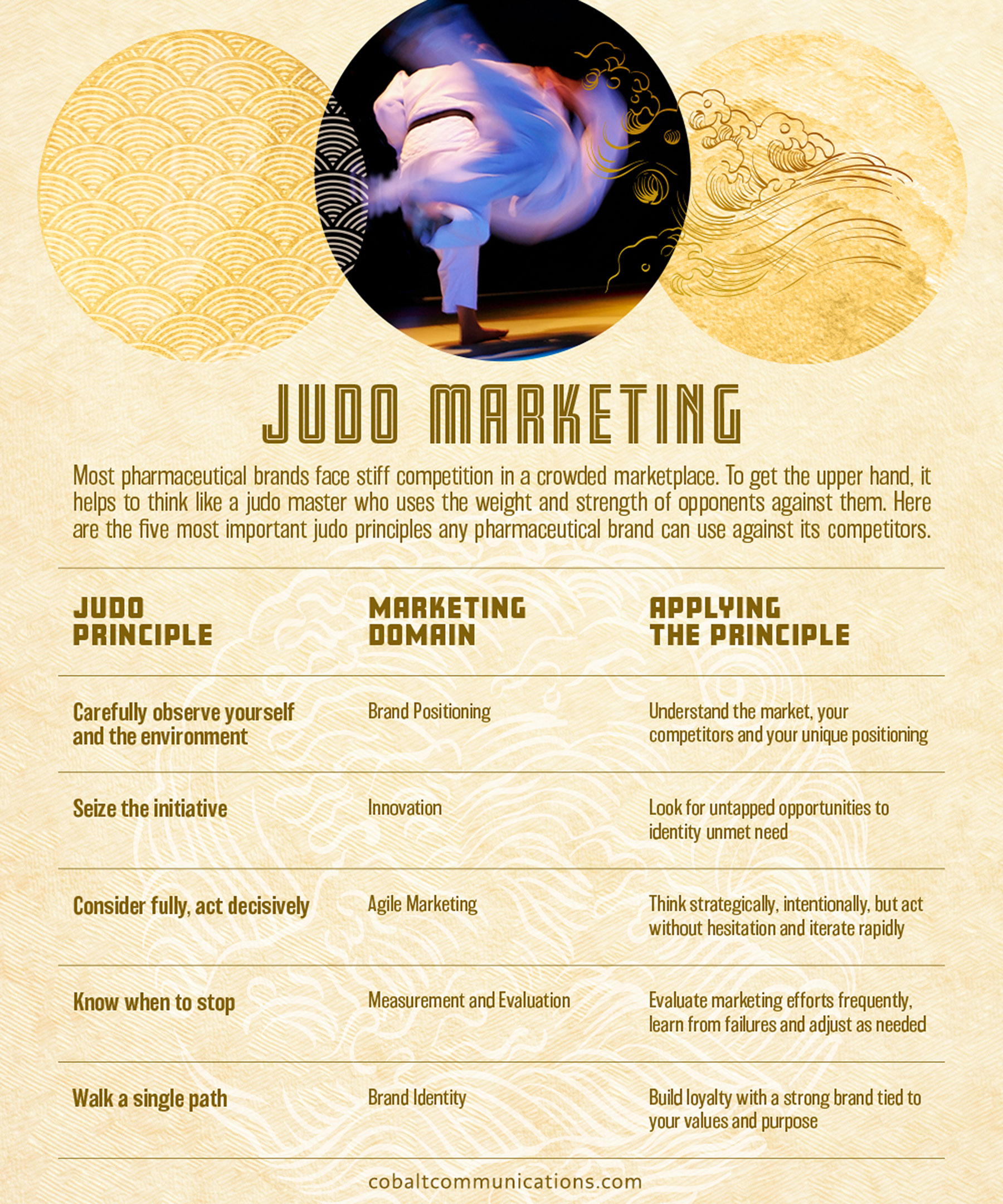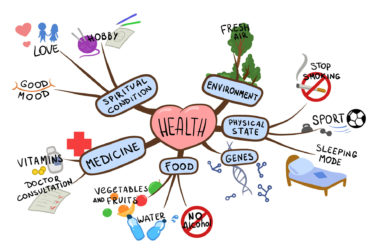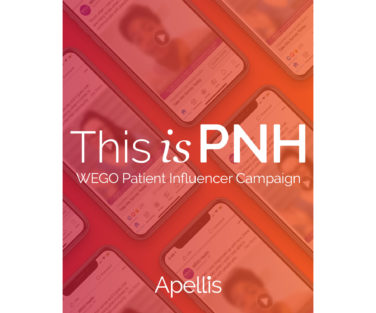In the world of branding, everything boils down to positioning—making sure your brand can be distinguished from other similar brands so you can outcompete and win. This very definition implies conflict: two brands engaged in physical combat until one competitor gains the upper hand and takes control of the market. Is it any wonder that the principles of judo get associated with branding and marketing? Judo is a modern Japanese martial art that involves flexibility and leverage, using the weight and strength of opponents against them. In judo, you don’t have to be bigger and stronger—you must be smarter and more efficient.
Judo was developed in the late 1800s by Jigoro Kano, who took elements from jujitsu and folded in his own ideas about perfectly balancing mental and physical discipline. The result was a unique sport embracing five key principles: (1) observe yourself and your environment; (2) seize the initiative; (3) consider fully yet act decisively; (4) know when to stop; and (5) walk a single path, staying in the middle. In many ways, Kano used these very principles to market the new sport outside of his home country. He traveled the world to share his vision and philosophy, using his leverage and keen intellect to pave the way for Japan’s participation in its first Olympics in Stockholm in 1912, and for the acceptance of judo as an Olympic discipline in Tokyo in 1964.
You don’t have to be a judo sensei to apply the same principles Kano introduced to the world. In fact, modern branding, by its very nature, is a study of judo techniques. This article will explore how life sciences marketers can increase their competitive advantage by applying the discipline’s basic principles to their own strategies.
 Observe Yourself and Your Environment
Observe Yourself and Your Environment
Kano’s first judo principle emphasizes the importance of self-awareness. A pharmaceutical brand must survey the landscape and identify its place of strength and its adversaries within the market. Without this unflinching analysis, it’s impossible to determine where and how to apply leverage most effectively.
In terms of branding, this judo principle lies at the nexus of three interrelated concepts: market research, competitive analysis, and brand positioning. Qualitative and quantitative research help pharma brand teams understand physician and patient attitudes, behaviors, and perspectives. Competitive analysis is a proactive, structured process to identify competitors, determine their strengths and weaknesses, and assess the products and services they offer. Using this information, savvy marketers develop a strong position that reinforces the unique value of their product relative to the competition.
For example, consider a pharma brand team trying to market its newest triple inhaler therapy for the treatment of COPD against its top competitor. The brand team knows that its dry-powder, once-daily inhaler is easier to properly administer because it doesn’t need to be shaken. Patient interviews might reveal that the competitive triple inhaler therapy—a twice-daily aerosol—must be shaken and has issues with adherence and administration. This differentiation provides just enough advantage for a judo marketer to exploit a weakness.
Seize the Initiative
Self-reflection and competitive analysis may seem like passive activities, but they set the stage for innovation and forward motion. Only big pharma companies have the luxury of a wait-and-see strategy because they benefit from maintaining status quo. Smaller biotechs, however, must rely on judo principles to win against the bigger competitors. They have the upper hand when it comes to making decisive moves to exploit opportunities—or fix problems—with agility. The close working relationships between decision-makers and those on the “front lines” fuels innovation and enables rapid deployment.
Nowhere is seizing the initiative more obvious than in mRNA technology. Smaller biotechs saw the promise of mRNA science in the early 2000s. They challenged the conventional wisdom of biologics manufacturing by investigating an entirely novel approach: introducing single-stranded RNA into human cells to manufacture their own therapeutic proteins. This is the perfect example of solid competitive analysis. You understand your industry and the limitations of current production models, then you move quickly to develop a solution that challenges the norms and disrupts the industry.
Moderna Therapeutics is a poster child for innovation and agility. Founded in 2010 to explore mRNA as a therapeutic platform, it was ready to act when the COVID-19 pandemic hit. Within a year of the outbreak, the Moderna COVID-19 vaccine received emergency use authorization in the U.S. Within weeks, millions of doses of vaccines were being shipped out—and the industry faced new expectations for vaccine development and production timelines.
Consider Fully, Act Decisively
Full consideration is a natural corollary to observing yourself and your environment—in fact, successful application of this third principle relies heavily on building and keeping those observations current. Sometimes marketers will have the luxury of contemplation, but the more competitive the marketplace, the more likely it is that delays will weaken a position. SWOT analyses still play a major role in crisis response in any PR and marketing war room, but they only reveal critical leverage points and identify obstacles when based on self-awareness and understanding of the competitive landscape.
Some of this urgency is inherent to the industry. When rosuvastatin entered the statin market in 2003, it faced the daunting challenge of competing against behemoths atorvastatin and simvastatin. It also faced negative press when The Lancet published an editorial condemning the quality of its clinical trials. The brand marketers were at a strategic crossroad, but they looked at the potential of their product and its differentiation from the competitors in the market and quickly decided to forge ahead, standing by rosuvastatin’s superior potency and tolerability. After additional clinical trial data showed rosuvastatin could reduce the risk of cardiovascular events, the statin became the most prescribed drug in U.S. history. Its success clearly demonstrates the benefits of careful consideration balanced with decisive action.
Know When to Stop
As many colleagues in R&D know, there comes a time when you must step back and say, this isn’t working. For the pharmaceutical industry, where more than 90% of new drug compounds never make it to market, being able to identify the “no-go” moment earlier rather than later saves millions of dollars.1 Beyond the financial aspect, a fail-fast mentality embraces failure as an opportunity to learn. It supports taking risks, recognizing that when something isn’t working you can simply “call it,” minimizing losses and regaining momentum.
Thanks to near-real-time metrics across multiple online channels and rapid data collection and reporting capturing offline behaviors, it is possible to quickly evaluate marketing campaign performance with enough time to identify underperforming strategies and experiment with new ones. Small-scale tests of marketing tactics can guide decisions about where to experiment or not before making big changes.
Encouraging teams to embrace fast failure can unlock engagement, creativity, and innovation. To build an environment where experimentation and failure are encouraged and “safe” requires effective communication and role modeling. By sharing stories of experimental initiatives that were deemed a “no-go” learning opportunity that supported future success, leaders and other influencers can destigmatize the subject and focus on how trial and error is a part of growth.
Walk a Single Path
In judo, walking a single path means never getting too confident when winning, while never feeling broken by losing; not letting your guard down when all seems quiet, and not giving up when facing many obstacles. In other words, maintain a balanced and steady flow of energy and effort to be ready to respond to a new challenge or seize a new opportunity.
Building and maintaining a solid brand identity is one way that marketing professionals help life sciences businesses stay balanced and prepared for both challenge and change. Brand identity and brand values are the core building blocks of a company’s image and the primary way they connect with customers and build loyalty. A brand is more than a logo and color palette; it reflects a company’s mission, values, personality, and voice, and it defines how people perceive your business. A strong brand identity, whether it’s a business entity or a product, enables the balance required to walk a single path by strengthening the connections between your brand and your audience. When that connection is in place—when a brand is associated with quality, performance, safety, responsibility—you have a platform to stand on in times of adversity, and a position to launch from when introducing new products to the market.
When you have an audience, internal or external, that believes in your brand, you have supporters who will take the time to listen to what you have to say. Having the attention of your audience means you’re ready to act, to respond…and to succeed.
References:
1. Lowe, Derek. “The Latest on Drug Failure and Approval Rates.” Science. https://www.science.org/content/blog-post/latest-drug-failure-and-approval-rates.










